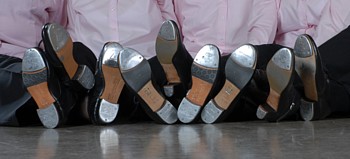FAQ – Everything you ever wanted to know about stepdancing but were afraid to ask
 I've never done stepdancing before and would like to start a course – what do I have to bring with me?
I've never done stepdancing before and would like to start a course – what do I have to bring with me?The most important things are comfortable clothes and a pair of reasonably suitable shoes – wait until you know you enjoy it before buying special tap shoes. Suitable shoes for jazz tap (American tap dancing) could be comfortable shoes with a hard leather or plastic sole and heels, which are not too high. If your feet easily slip out of the shoes, they are not suitable.
For Irish Dancing you first need some pumps – these could be for gymnastics, ballet or jazzdance or even, in an emergency, non-slip socks. These are for softshoe dancing. For Irish hardshoe dancing the same applies as for jazz tap.
How can I tell, if I'll enjoy it?
By taking a free trial lesson with us. Before you register and sign a contract you can try out our regular courses with no obligation. Don't worry: We'll soon have you up and dancing …
What is the difference between Irish and American step/tap dancing?
Music: Irish stepdancing is danced to traditional Irish music – jigs, reels & hornpipes. American tap dancing developed alongside jazz but is now at home with almost every style of music imaginable. Posture: American tap is loose. The more relaxed the dancer, the better. An Irish dancer is instantly recognisable from the extremely upright posture. This has consequences for the movements of the legs even if the foot technique is often identical. Fitness: American tap can be a bit tiring but does not have to be. Irish stepdancing is always strenuous and can become a high-performance sport. Jazz or Rhythm Tap versus Musical Tap: American tap has many different faces. The best known of these are Jazz Tap, where the dancers becomes a musical instrument with his ears as close to his shoes as possible, and Musical or Broadway Tap, in which the visual dance elements take the leading role. Softshoe or Hardshoe: Irish dancing is not just about making noise with your feet. The elegant, floating style of Irish softshoe dancing is an integral part of the dance form (the uninitiated often mistake it for ballet). Shoes: American tap shoes have metal plates on the soles. Irish dancing uses reinforced fibre-glass (wood used to be used).
Both forms of dance have long traditions and even developed together for parts of their histories. But there are also other forms of percussive dancing, which have grown up (or survived in isolation) alongside these two most famous forms of step dancing in the New World of the Americas (Appalachian Flatfooting, Modern Clogging, Cape Breton Stepdancing). Indeed, step- and tap dancing have further roots in other forms of dance from the Old World of Europe (e.g. Scottish Hardshoe Dancing, English Clogging).
I'm already more than 20 / 30 / 40 / 50 / 60 / 70 years old – do I still have any chance of learning to dance?
Don't let a number beat you! Your level of fitness is much more important than your age. Irish Dancing: This dance form can become a high-performance sport – but it doesn't have to be that way. In any case, you should be prepared to sweat a little. The level you achieve as a dancer depends, among other things, on your body's anatomical shape (shape of the hip joints, general flexibility). If you start as an adult you will never achieve the same remarkable level of performance that Irish children can achieve when they start at three years old. However, that has no influence on the fun factor!
American Tap: Jazz Tap, in particular, has an enormous respect for age! Age is no restriction for this dance form. If you can walk, you can learn to tap.
Please always inform your teacher if you have any old injuries to your knees, feet or hips or if you know you have any back problems. Please ask your doctor for advice as well if you are undergoing treatment.
Is this dance form suitable for children?
You bet it is! In Ireland, children start learning their country's traditional dance form as early as three years old. And Sammy Davis Jr. was a successful stage performer at 5 years old! There are very few sports, which help children to develop such a wide range of skills: these forms of dance promote a sense of music and rhythm as well as training all levels of motor skills. Occasional performances also build children's confidence and the regular training is an excellent workout. We offer courses for children from the age of 8 years and upwards – just ask about course availability or when the next course starts.